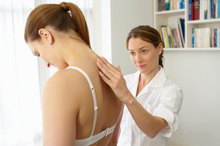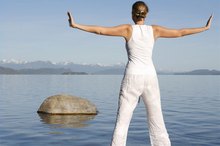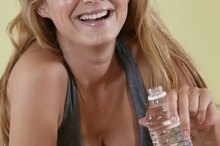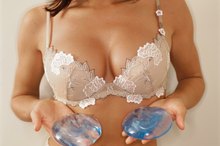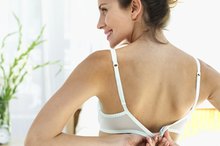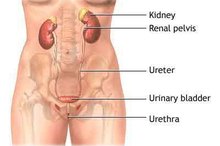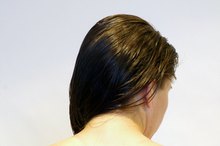What does fact checked mean?
At Healthfully, we strive to deliver objective content that is accurate and up-to-date. Our team periodically reviews articles in order to ensure content quality. The sources cited below consist of evidence from peer-reviewed journals, prominent medical organizations, academic associations, and government data.
- American Academy of Family Practice: Breast Pain in Women
- Medicine and Science in Sports and Exercise: Breast Elevation and Compression Decrease Exercise-Induced Breast Discomfort
- Medicine and Science in Sports and Exercise: Breast Elevation and Compression Decrease Exercise-Induced Breast Discomfort
- Journal of Sports Sciences: Supported and Unsupported Breast Displacement in Three Dimensions Across Treadmill Activity Levels
- Journal of Sports Sciences: Supported and Unsupported Breast Displacement in Three Dimensions Across Treadmill Activity Levels
- Journal of Science and Medicine in Sport: An Analysis of Movement and Discomfort of the Female Breast During Exercise and the Effects of Breast Support in Three Cases
- Journal of Science and Medicine in Sport: An Analysis of Movement and Discomfort of the Female Breast During Exercise and the Effects of Breast Support in Three Cases
The information contained on this site is for informational purposes only, and should not be used as a substitute for the advice of a professional health care provider. Please check with the appropriate physician regarding health questions and concerns. Although we strive to deliver accurate and up-to-date information, no guarantee to that effect is made.
Can Your Breasts Hurt From Certain Weight Machines?
Mastalgia, the medical term for breast pain, can be frightening to a woman whose first thought is that the pain may signal cancer 2. Luckily, breast pain is rarely related to cancer, but women who exercise regularly may have breast pain for a number of reasons. Weight machines may be a source of breast pain for some women. Consult a healthcare professional if you have chronic breast pain.
If you are experiencing serious medical symptoms, seek emergency treatment immediately.
Breast Anatomy
The breast itself has no muscles; it's mostly fatty tissue surrounded by skin that lies on top of the pectoral muscles. The fatty tissue has threads of connective tissue running through it that help to support the breast. Milk glands and milk ducts comprise the remaining structures of the breast. The milk ducts drain into the nipple, which is located roughly in the middle of the breast.
- The breast itself has no muscles; it's mostly fatty tissue surrounded by skin that lies on top of the pectoral muscles.
- The fatty tissue has threads of connective tissue running through it that help to support the breast.
Weight Machines and Pectoral Muscles
The Effects of Sagging Breasts on Back Pain
Learn More
Weight machines or exercises that are designed to work the pectoral muscles can cause muscle soreness that may be felt as breast pain. The primary function of the pectoral muscles is to help the arms and shoulders move and lift, but because they lie under the breasts, a strain or soreness in these muscles can be perceived as breast pain. Chest press machines and cable crossover machines are two types of exercise machines designed to work the pectoral muscles.
Large Breasts and Jogger's Nipple
Women who have large breasts may be more prone to breast pain when they exercise because the weight of the breast pulls on the pectoral muscles and supporting tissue of the breast. Another possible source of breast pain from weight machines is a condition called “jogger’s nipple.” This condition is frequently found in runners and is caused by friction of the nipple moving against fabric, such as a bra or shirt.
Breast Movement and Speed
What Are the Treatments for Breast Ligament Pain?
Learn More
A research study reported in the January 2011 “Journal of Sports Sciences” found that breasts move in four different directions during exercise 5. Researchers commented that most sports bras aren't designed to handle that much motion. Excess breast movement could contribute to breast pain.
Sports Bras
There are several strategies that can help with breast pain from exercise. Wear a good sports bra that provides optimum support. Research reported in the June 1999 “Journal of Science and Medicine in Sport” found that the use of a sports bra during exercise was the best choice of four possible bra options 5. Another study in the July 2010 “Medicine and Science in Sports and Exercise” reported that for women who have large breasts, the bra should both elevate and compress the breasts.
- There are several strategies that can help with breast pain from exercise.
- Research reported in the June 1999 “Journal of Science and Medicine in Sport” found that the use of a sports bra during exercise was the best choice of four possible bra options 5.
Considerations and Warnings
Other strategies include exercising slowly to prevent excess breast motion, the use of ice applied to sore breasts after a workout and the use of over-the-counter pain medications. If your breasts become tender prior to a menstrual period, you may want to avoid using machines that work the pectoral muscles for a few days. Muscle soreness should go away after a day or so. If breast pain continues or becomes more severe, consult a healthcare professional.
- Other strategies include exercising slowly to prevent excess breast motion, the use of ice applied to sore breasts after a workout and the use of over-the-counter pain medications.
- If your breasts become tender prior to a menstrual period, you may want to avoid using machines that work the pectoral muscles for a few days.
Related Articles
References
- American Academy of Family Practice: Breast Pain in Women
- London Breast Care Centre: Mastalgia
- Medicine and Science in Sports and Exercise: Breast Elevation and Compression Decrease Exercise-Induced Breast Discomfort
- Journal of Sports Sciences: Supported and Unsupported Breast Displacement in Three Dimensions Across Treadmill Activity Levels
- Journal of Science and Medicine in Sport: An Analysis of Movement and Discomfort of the Female Breast During Exercise and the Effects of Breast Support in Three Cases
- Goyal A. Breast pain. BMJ Clin Evid. 2014;2014:0812.
- Eren T, Aslan A, Ozemir IA, et al. Factors affecting mastalgia. Breast Care (Basel). 2016;11(3):188-93. doi:10.1159/000444359
- Kataria K, Dhar A, Srivastava A, Kumar S, Goyal A. A systematic review of current understanding and management of mastalgia. Indian J Surg. 2014;76(3):217-22. doi:10.1007/s12262-013-0813-8
- Cancer Research UK. Fibrocystic breast changes. September 20, 2017.
- Koo MM, von Wagner C, Abel GA, McPhail S, Rubin GP, Lyratzopoulos G. Typical and atypical presenting symptoms of breast cancer and their associations with diagnostic intervals: evidence from a national audit of cancer diagnosis. Cancer Epidemiol. 2017;48:140-6. doi:10.1016/j.canep.2017.04.010
- Cuhaci N, Polat SB, Evranos B, Ersoy R, Cakir B. Gynecomastia: Clinical evaluation and management. Indian J Endocrinol Metab. 2014;18(2):150-8. doi:10.4103/2230-8210.129104
- National Institute on Aging. Shingles. October 29, 2018.
- Jokich PM, Bailey L, D'Orsi C, et al. ACR appropriateness criteria breast pain. J Am Coll Radiol. 2017;14(5S):S25-33. doi:10.1016/j.jacr.2017.01.028
- American Cancer Society. American Cancer Society recommendations for the early detection of breast cancer. 2017.
Writer Bio
Beth Greenwood is an RN and has been a writer since 2010. She specializes in medical and health topics, as well as career articles about health care professions. Greenwood holds an Associate of Science in nursing from Shasta College.
